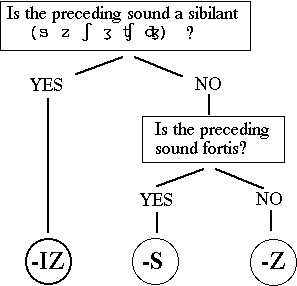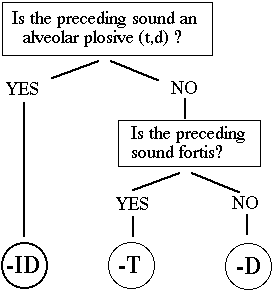 -ED INFLECTIONS
-ED INFLECTIONS
Remind yourself first of the flowchart for -s inflections ( ):
):

It turns out that the the rules for -ed inflections follow the same pattern: the ending is
- -

 if the inflection follows another ALVEOALR PLOSIVE (t or d)
if the inflection follows another ALVEOALR PLOSIVE (t or d)
| wanted |
       |
minded |
       |
| batted |
      |
skidded |
       |
| rooted |
      |
crowded |
       |
| parted |
      |
waded |
      |
- -t if the inflection follows a a FORTIS consonant other than t - (






 )
)
| stopped |
     |
kissed |
    |
| barked |
    |
washed |
    |
| laughed |
    |
stitched |
     |
| berthed |
    |
|
|
- -d in all other cases
| rubbed |
    |
seized |
    |
| climbed |
     |
raged |
    |
| stoned |
     |
bagged |
    |
| loved |
    |
brewed |
    (= brood) (= brood) |
| mouthed |
    |
filled |
    |
| lied |
   |
poured |
   (= pawed) (= pawed) |
So the flowchart for -ed endings is:

You can also find this information in Wells's Longmans Pronunciation Dictionary under "-ed", p.249 (p.xxx in older editions)
THIS MEANS THAT both -s and -ed inflections follow the same - or at least similar - rules. We could formulate them like this:
- If the ending is THE SAME SORT OF SOUND as the sound in front of it --
i.e. if -s comes after a SIBILANT or -ed comes after an ALVEOLAR PLOSIVE t or d --
then the ending is  + the lenis version of the ending (z or d)
+ the lenis version of the ending (z or d)
- If the sound in front is FORTIS the ending is the FORTIS version of the ending (s or t)
- Otherwise, the ending is the LENIS version of the ending (z or d)
Which gives us this flowchart:

(= brood)
(= pawed)